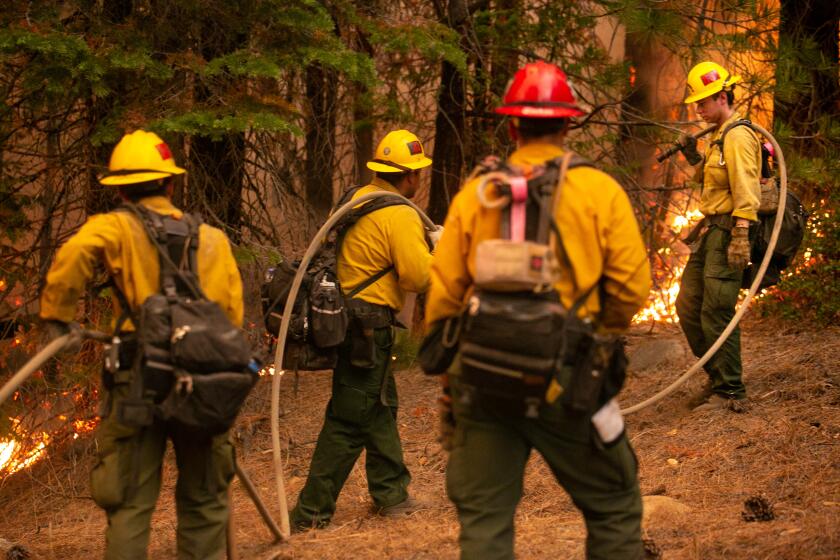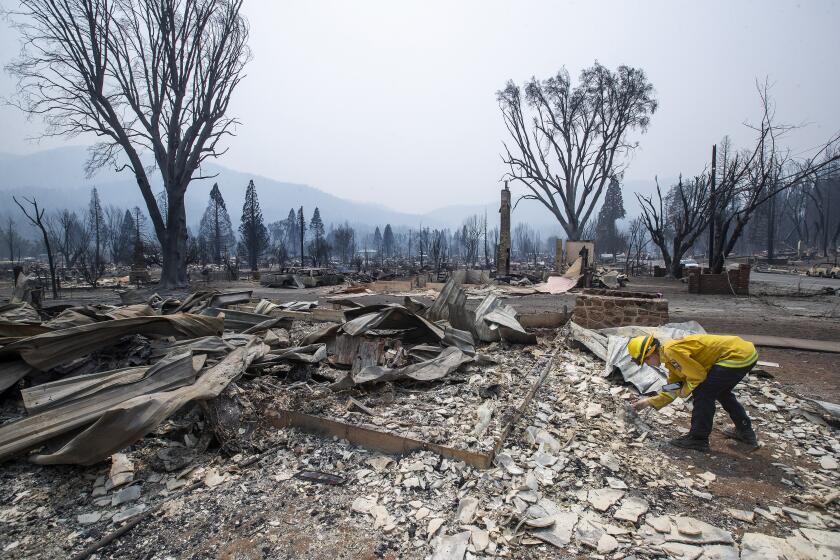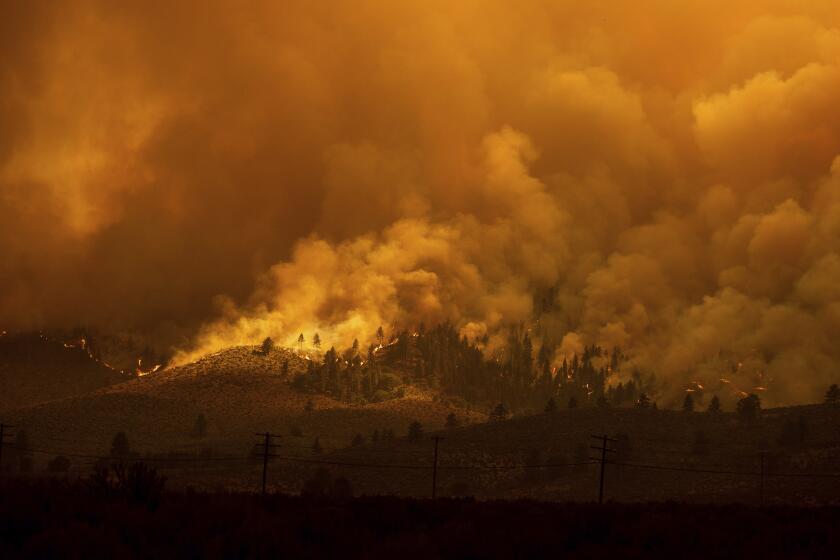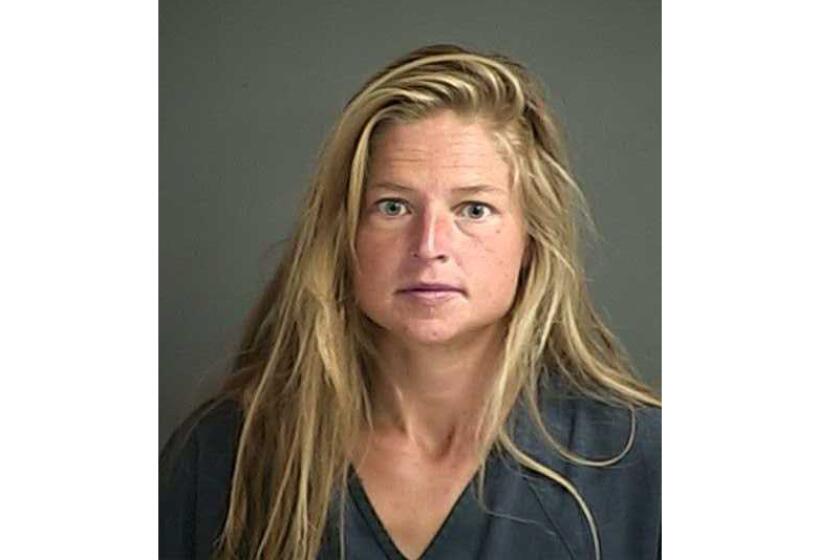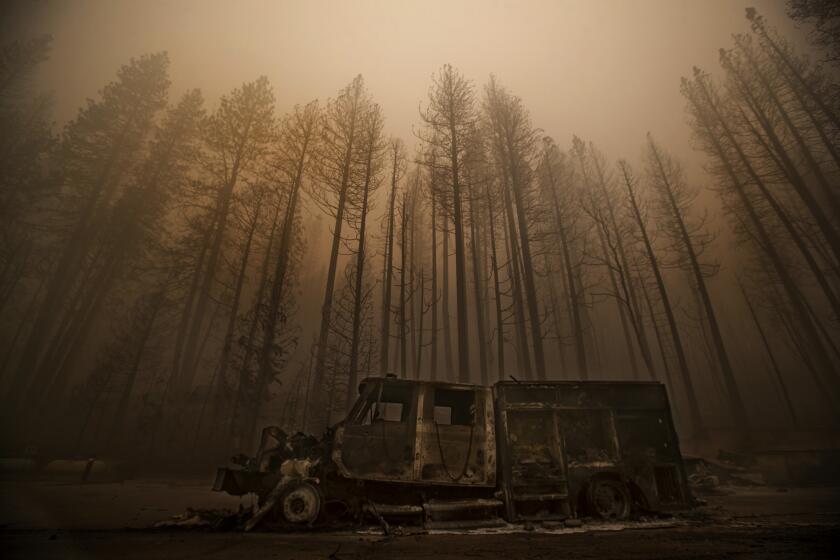Is wildfire arson getting worse in California? Climate change doesn’t help
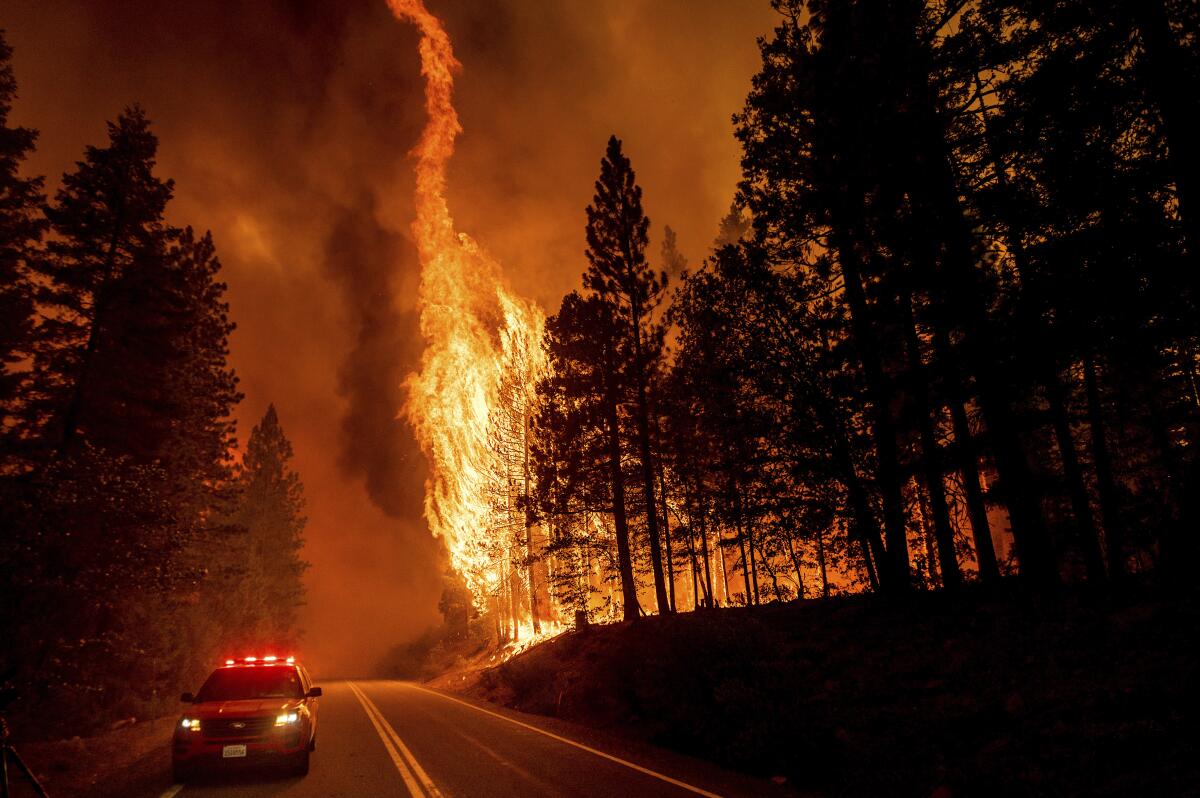
- Share via
A college professor. A Caltech grad. A woman in a bikini. And, just this month, a father and son.
A confounding collection of Californians have been accused of contributing to one of the worst wildfire seasons in state history — a season that saw three killed, thousands of homes leveled and more than 2.5 million acres burned.
While fires ignited by downed power lines and lightning have caused widespread destruction in recent years, this last wildfire season was unusual for the number of large fires that were linked to arson. Wildfire arson arrests have been climbing over the last few years: In 2021, the California Department of Forestry and Fire Protection reported 140 arrests by its law enforcement division — 20 more than last year and double the number of 2019.
To some, the apparent surge in arson incidents has been a troubling new development in California’s ever-worsening wildfire regime, and it has even given rise to a raft of conspiracy theories. Yet experts say the attention-grabbing headlines and uptick in arrests belie an enduring truth: Arson represents only a fraction of California’s fire starts each year.
What has changed, they say, is that bone-dry drought conditions and overgrown forests have enabled even the smallest of sparks to explode into an inferno.
“Once they put that fire on the ground, they have no control over how it will grow,” said Gianni Muschetto, chief of Cal Fire’s law enforcement division.
After David Scott Smith and his son, Travis Shane Smith, were arrested a day earlier, prosecutors filed several felony charges against them Thursday.
In California, lawmakers distinguish between two types of arson: willful, malicious arson and reckless arson, such as when a person sets off fireworks in dry brush, Muschetto said. Identifying the source of a wildfire is one of the more technical jobs in law enforcement, and in 2019 — the most recent year for which he had data — the causes of the majority of California’s wildfires were undetermined. Electrical equipment accounted for about 12% and lightning 6%.
But arson was also a factor, sparking about 9% of fires in 2019, and roughly 8% to 10% of the state’s wildfires in any given year. In 2021, when Cal Fire responded to more than 8,600 fires, that could mean as many as 800 blazes.
One of the alleged arsonists who made national headlines this year was Gary Maynard, a former college professor linked to an “arson-setting spree” near the site of the Dixie fire, the second-largest wildfire in California’s recorded history.
Maynard was charged with willfully starting four fires in the Shasta-Trinity and Lassen national forests in July and August. Some of the blazes were set behind fire lines and in evacuation zones, with investigators in one instance identifying sticks, newspaper material and a wooden match in a burned area on the ground.
He has pleaded not guilty to all charges, his attorney said via email.
Witnesses at the scene said Maynard appeared to be mentally unstable. Officials confirmed that he had previously worked at two California universities, where he taught seminars in criminology and criminal justice.
Gary Stephen Maynard, 47, has been charged with willfully starting the Ranch fire and has been linked to at least six other blazes.
The circumstances around Maynard and other arson suspects prompted a wave of speculation among far-right groups and conspiracy theorists, with some falsely suggesting that members of Antifa were intentionally setting fires as part of an elaborate political plot.
But the motives for arson are more complex than that, said Glenn Corbett, an associate professor of fire science and public administration at the John Jay College of Criminal Justice.
“There’s dozens of reasons why people start fires,” Corbett said, listing examples such as malice, recklessness, revenge, mental health issues or even just “bad behavior.”
The latest string of high-profile cases “to some extent trend with social upheaval,” Corbett said, including the COVID-19 pandemic and growing political and economic divides. “Sometimes those end up being ‘trigger events’ that sort of release people to do things that they probably wouldn’t normally do.”
But arson-related fires are especially dangerous given the record-setting heat and drought across the West, which have dried the landscape and primed it to burn — leading to faster, hotter and more intense wildfires than ever before.
“The volume, the size, the ferocity of fire is tied directly to what’s burning,” Corbett said. “High levels of dryness and low levels of humidity and no rain ... that’s a prime situation for having a fire, and certainly one that is very difficult to contain.”
The dryness of the vegetation, primed by both long-term drought and shorter-term heat waves, is making it easy for fires to ignite and even easier for them to spread.
One blaze that quickly grew out of control was the Fawn fire in Shasta County, which was allegedly ignited by a 31-year-old Caltech alumna named Alexandra Souverneva, who authorities say was found with CO2 cartridges and a lighter near where the fire ignited.
The fire grew quickly amid dry timber and heavy winds. By the end of its 10-day run, it had injured three firefighters, destroyed 185 buildings and charred more than 8,500 acres.
In December, Souverneva was ordered to a state mental hospital after a judge found her mentally unfit to stand trial. Her attorney did not respond to a request for comment.
But legal experts say her case and others like it raise important questions about how the state responds to instances of arson, which often involve external factors such as homelessness, mental health and drug use.
“The issue is not whether the punishment fits the crime — it’s that the punishment of incarceration doesn’t necessarily get to the root of the problem,” said Louis Shapiro, a defense attorney and former public defender in Los Angeles.
“Most arsonists have mental health issues which, if were timely treated, would avoid the arson fires from starting altogether,” he said. The “government needs to get ahead of these issues and proactively help those with mental health issues, rather than react to the damage after the fact. That is where the focus needs to be.”
Joel Dvoskin, a forensic psychologist who has studied arson, said it’s important to distinguish between people with mental disabilities and people experiencing emotional crises.
“When people do arson that’s only intended to cause destruction, that’s a despairing thing to do, and we live in a time when a lot of people are experiencing fear, anger and despair,” he said. “Those are the three emotions that cause so much damage in our world, and I doubt that arson is an exception.”
Like Shapiro, he said incarceration isn’t always the answer, particularly since the reasons for committing arson are so varied and complex.
In California, the penalties for arson can include fines or several years of imprisonment. Shapiro said the outcomes of cases resulting from negligence — such as a 2020 wildfire ignited by a pyrotechnic device at a gender-reveal party — are harder to predict and largely depend on the way the sentencing judge views the case.
That fire, dubbed the El Dorado fire, went on to burn more than 22,000 acres and kill a firefighter.
Alexandra Souverneva has been charged with felony arson and committing arson during a state of emergency.
It’s an example of the kind of blaze that might have sputtered in a wetter climate but instead fed on hot, dry conditions that turned it into a monster, said Ed Nordskog, an arson investigator and co-author of “Arson Investigation in the Wildland.”
“The fuel is so dry because of the climate, and of course if there’s any sort of wind, that fire’s gone off to the races,” he said.
Still, what seems like a trend of arson in California may not actually reflect an increase in the number of people setting fires. California has more arson investigators than any other state and is becoming more proficient at catching offenders, Nordskog noted. States such as Colorado that may seem to have fewer instances of arson don’t have as many investigators contributing to their statistics, he said.
Dmitry Gorin, a defense attorney and former prosecutor, similarly emphasized that the numbers remain small.
“You’re seeing a lot of [cases] in the news now, and they usually happen during the fire season when it’s dry with high winds, so we hear about them,” Gorin said, “but as a matter of percentage of criminal cases in court, they’re pretty rare, even in California.”
Some arsonists are easier to catch than others, such as the woman who admitted to starting a fire near South Lake Tahoe in August after she emerged from the scene in a bikini and “covered in scratches and soot.” Other cases are more complicated, including the large number of fires that are started by people living in the wildland-urban interface or people struggling with mental health issues and drug use, Nordskog said.
But in nearly all instances, the danger has gotten worse, he said. “Every fire has the potential to be a giant megafire.”
New study says climate change is essentially two-thirds to 88% responsible for the conditions driving wildfire woes in the western United States.
Earlier this month, prosecutors filed reckless-arson and firearm charges against David and Travis Smith, a father and son suspected of starting the Caldor fire near South Lake Tahoe. That blaze, along with the Dixie fire, became the first to ever burn from one side of the Sierra to the other, and leveled the Gold Rush-era mountain town of Grizzly Flats.
The Smiths’ attorney, Mark Reichel, said via email that they are “100% innocent” and even called for help as soon as they spotted the fire. They intend to beat all charges, he said.
But the outcome of the case won’t do much to budge statistics. Of the 140 arson arrests this year, only 29 were in the “reckless” category while 111 were willful, said Muschetto of Cal Fire. The agency issued about 360 citations for fire and fireworks violations this year.
Still, the confluence of cases and conditions is undeniably creating more challenges for the state’s residents and for those trying to protect them from the worst effects of wildfire.
“Whether it’s an accidental act or lightning or arson, that risk of those fires getting larger quicker is increasing with climate change,” Muschetto said.
More to Read
Sign up for Essential California
The most important California stories and recommendations in your inbox every morning.
You may occasionally receive promotional content from the Los Angeles Times.
